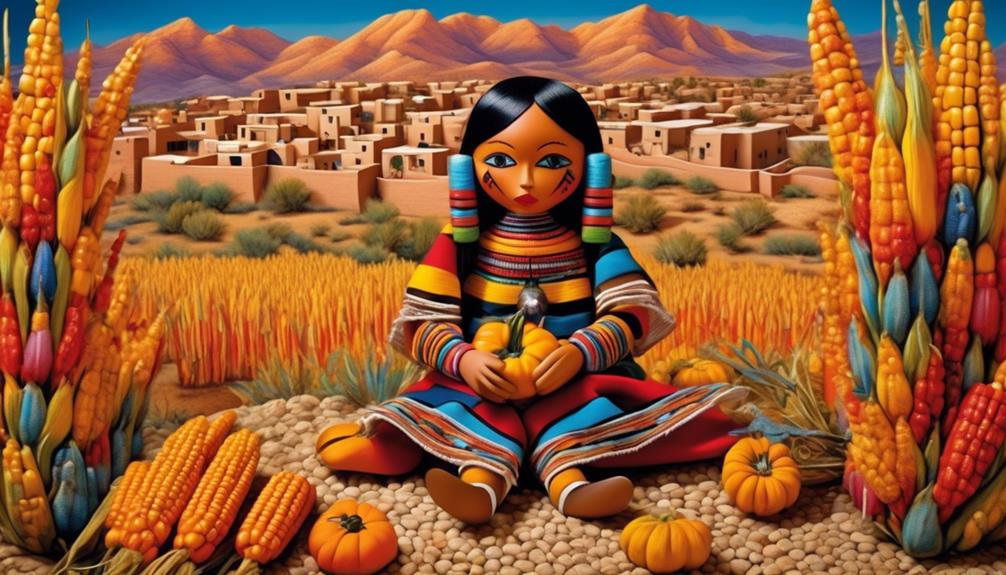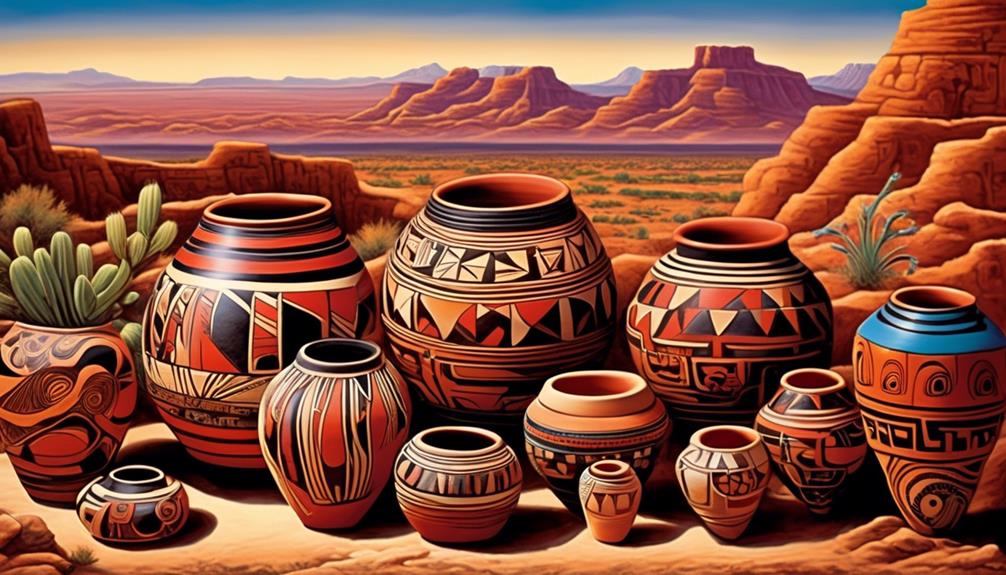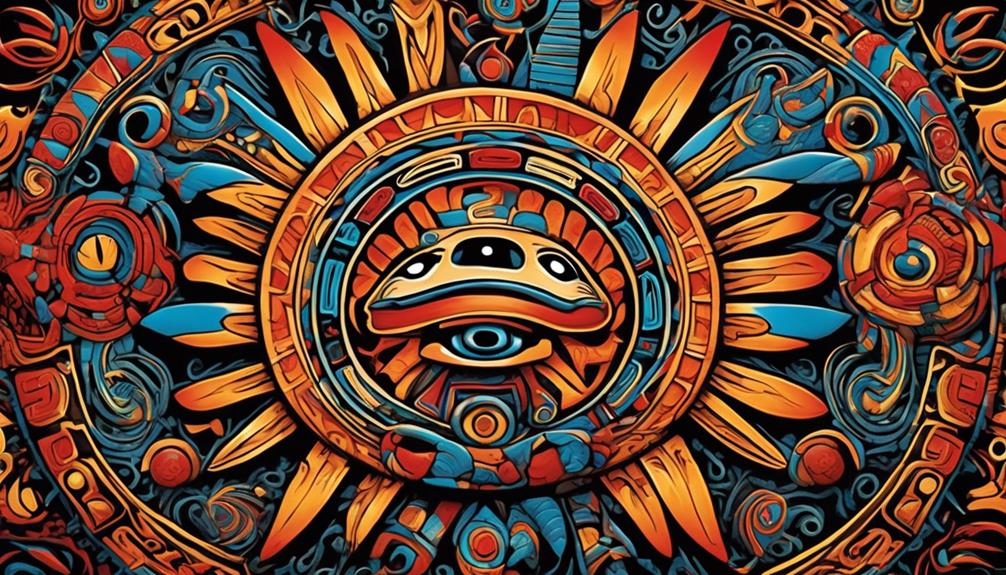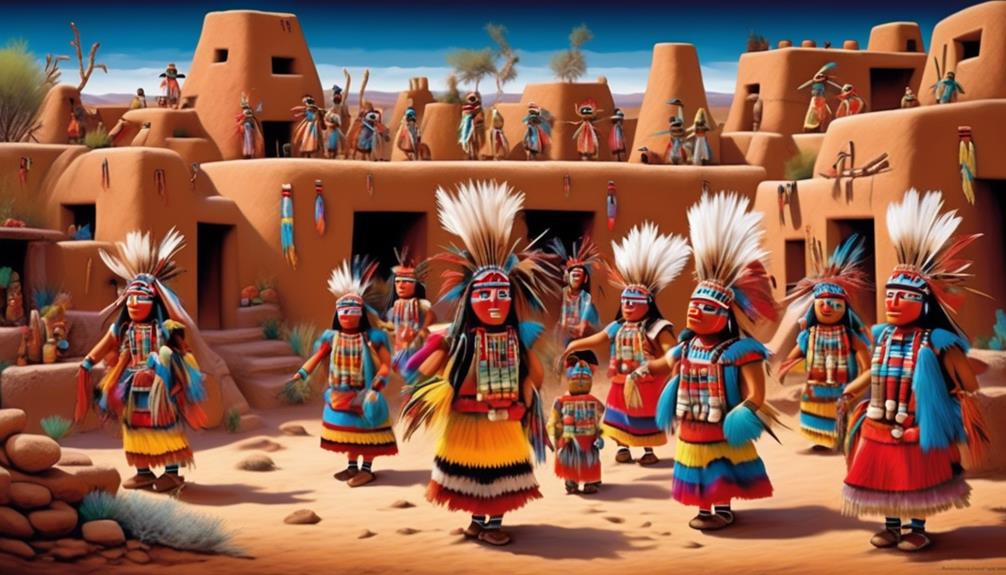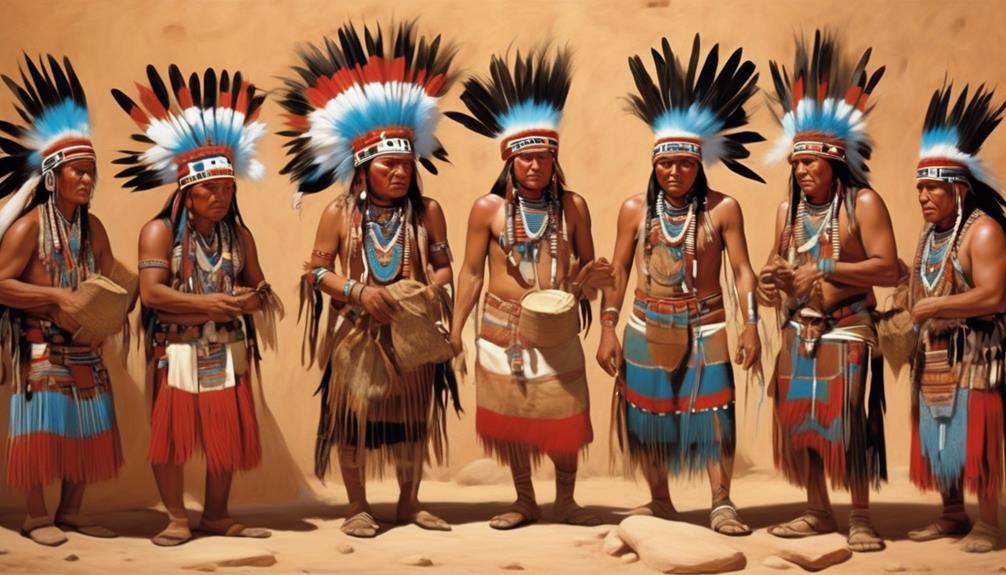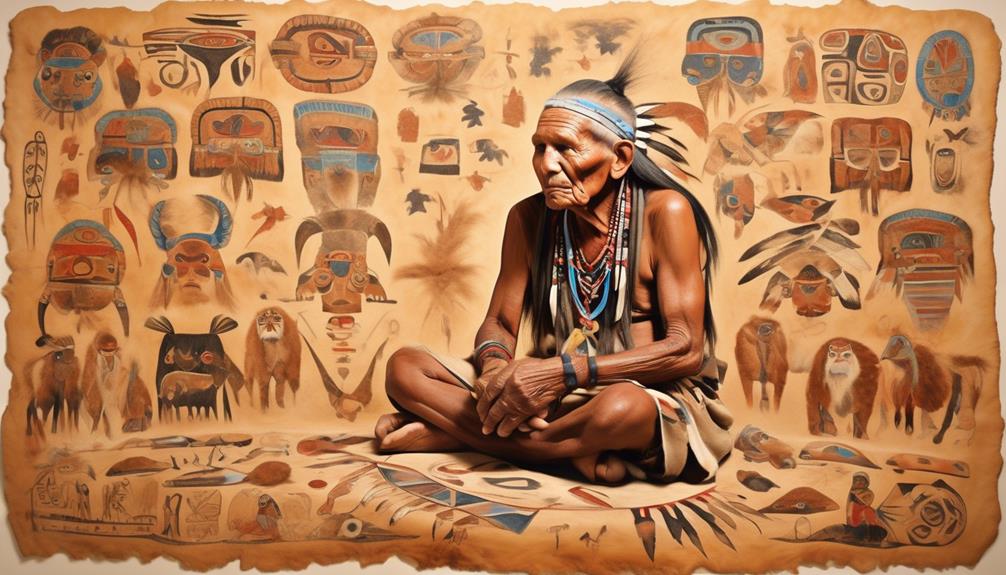When considering ancient civilizations, our minds typically conjure images of powerful empires and majestic pyramids. Nevertheless, the Hopi Tribe presents a distinctive outlook on the intricate societies of indigenous peoples.
Their history is both enigmatic and rich, filled with traditions that have endured for centuries.
But what did the Hopi Tribe mean in the broader context of Native American history and contemporary society?
There is much to uncover about their origins, spiritual beliefs, and contributions to the tapestry of Native American culture, which makes their story a compelling journey to explore.
Key Takeaways
- The Hopi Tribe has a strong connection to their ancestral roots and believes they were created and chosen for the Four Corners region.
- Tribal ceremonies, such as the Katsina Ceremonies and the Soyal Ceremony, are important for honoring ancestors and expressing gratitude.
- Symbolic artwork, including pottery, kachina dolls, and textiles, carries cultural significance and transmits the history and beliefs of the Hopi Tribe.
- The Hopi Tribe has made significant contributions to Native American culture through their artistic expressions, sustainable farming practices, and mastery of dry farming and water conservation techniques.
Origins of the Hopi Tribe
The origins of the Hopi Tribe can be traced back thousands of years, revealing a rich and intricate cultural history that's deeply intertwined with the land and the natural world. The Hopi people have maintained a strong connection to their ancestral roots, believing that they were created and chosen to reside in the region known as the Four Corners, where Arizona, New Mexico, Colorado, and Utah meet.
According to Hopi oral tradition, their migration patterns were guided by spiritual forces, leading them to settle in the mesas and villages that they inhabit to this day.
The ancestral roots of the Hopi Tribe are deeply embedded in their spiritual and cosmological beliefs, which are intricately linked to the landscape and natural elements of their homeland. The migration patterns of the Hopi people reflect their deep reverence for the land and their understanding of their place within the natural world.
Through their oral history and cultural practices, the Hopi Tribe continues to honor and preserve the traditions that have sustained them for millennia.
Cultural Significance and Traditions
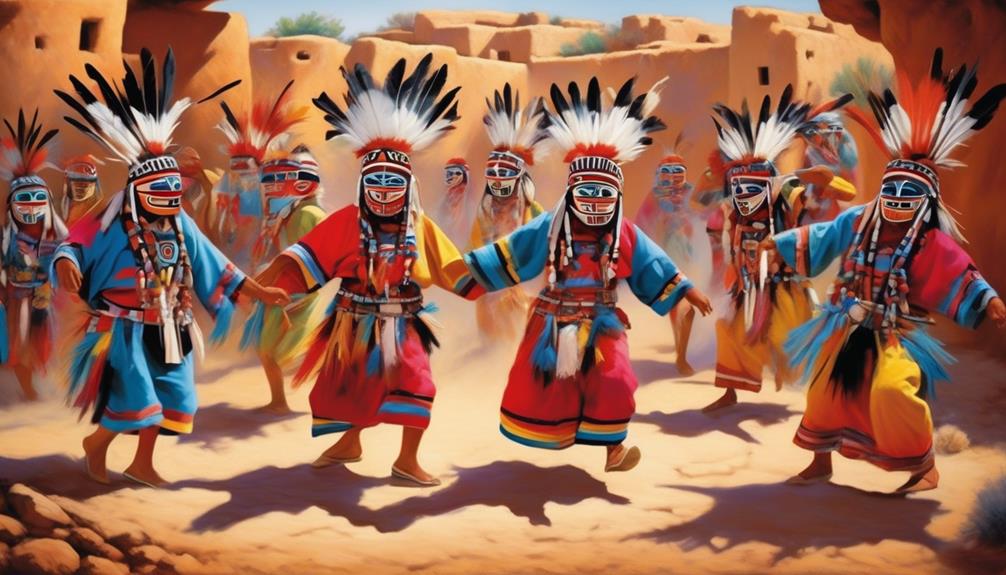
Embedded within the fabric of Hopi life are cultural practices and traditions that weave together the past, present, and future of this ancient tribe. Tribal ceremonies play a central role in Hopi culture, serving as occasions to honor ancestors, express gratitude for the earth's bounty, and seek blessings for the community's well-being. These ceremonies are deeply rooted in the Hopi belief system and are passed down through generations, preserving the tribe's spiritual connection to the land and the cosmos.
Symbolic artwork is another integral part of Hopi traditions, with each design carrying profound cultural significance. The intricate patterns and motifs found in Hopi pottery, kachina dolls, and textiles often depict stories of creation, migration, and the natural world. These art forms serve as a visual language, transmitting the tribe's history and beliefs to future generations.
The cultural significance of these practices and traditions can't be overstated, as they not only reinforce the Hopi people's sense of identity and belonging but also offer a window into the rich tapestry of their heritage. Through these enduring customs, the Hopi continue to uphold their traditions, fostering a profound connection to their ancestral roots.
Spiritual Beliefs and Practices
Deeply intertwined with our cultural practices and traditions, our spiritual beliefs and practices form the core of our Hopi identity and connection to the land and cosmos.
Our spiritual beliefs are rooted in the concept of Hózhó, which encompasses harmony, balance, and beauty in all aspects of life. Our ceremonies and rituals play a crucial role in maintaining this harmony and balance within our community.
- Katsina Ceremonies: These ceremonies involve the worship of ancestral spirits and deities, symbolizing the interdependence between the spirit world and the physical world.
- Prayer Sticks: We craft prayer sticks as a form of meditation and prayer, seeking guidance and blessings from the divine forces.
- Soyal Ceremony: This winter solstice ceremony marks the beginning of the Hopi year, involving purification rituals and prayers for the well-being of the community.
- Sweat Lodge: Through sweat lodge ceremonies, we cleanse our bodies and spirits, promoting healing and spiritual renewal.
- Corn Dance: The Corn Dance is a significant ceremonial ritual, expressing gratitude to the deities for the gift of corn and seeking their continued blessings for a bountiful harvest.
These meditation practices and ceremonial rituals are integral to our spiritual connection with the land and the cosmos, reinforcing our reverence for the natural world and our place within it.
Contributions to Native American Culture
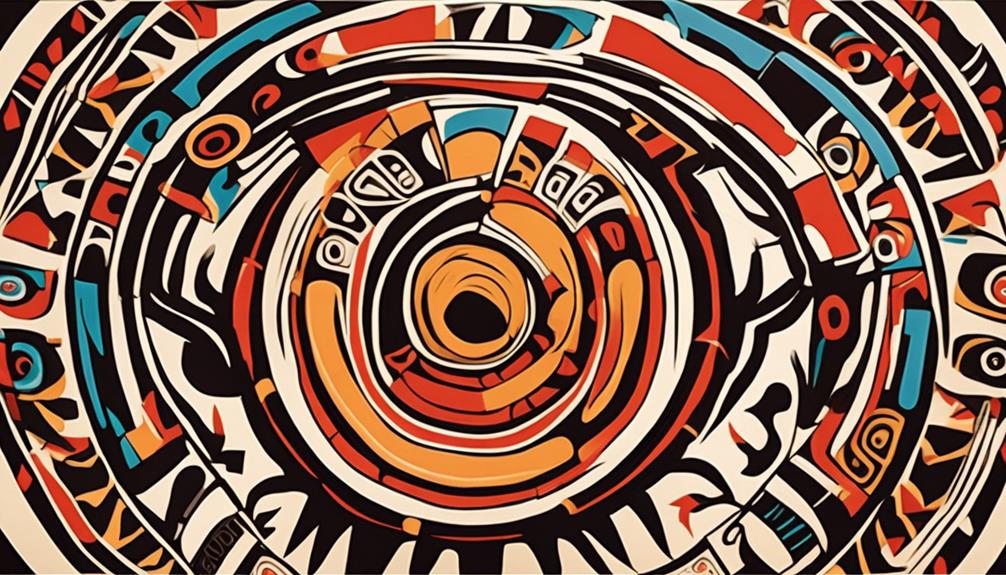
Influencing the rich tapestry of Native American culture, the Hopi tribe's contributions reflect a profound connection to tradition and a deep reverence for the natural world. Their artistic expressions, such as pottery, kachina dolls, and intricate textiles, are renowned for their intricate designs and vibrant colors, embodying spiritual symbolism and storytelling. These artistic traditions haven't only preserved the Hopi's cultural heritage but have also significantly influenced and inspired Native American art forms across different tribes.
Moreover, the Hopi tribe's agricultural techniques, particularly their mastery of dry farming and water conservation, have had a lasting impact on Native American agriculture. Their innovative farming methods, including the use of terraced fields and drought-resistant crops, have been crucial for sustaining communities in arid environments. Additionally, the Hopi's agricultural practices emphasize the importance of maintaining harmony with the natural world, serving as a model for sustainable and ecologically conscious farming practices among Native American communities.
Contemporary Relevance and Challenges
As we consider the contemporary relevance and challenges faced by the Hopi tribe, their enduring cultural traditions and innovative agricultural practices continue to serve as a source of inspiration and resilience within the ever-evolving landscape of Native American communities.
The Hopi tribe faces contemporary challenges in preserving their cultural heritage while navigating the complexities of modern society. In the face of these challenges, the tribe remains steadfast in their commitment to cultural preservation, striving to maintain their language, ceremonies, and artistic practices.
The Hopi tribe also grapples with issues related to land rights and environmental conservation, seeking to protect their sacred sites and traditional homelands amidst increasing external pressures.
Additionally, economic development and educational opportunities present ongoing challenges, as the tribe aims to balance modern advancements with the preservation of their unique way of life.
Despite these challenges, the Hopi tribe continues to adapt and innovate, finding new ways to uphold their cultural identity and traditions in the contemporary world.
- Preservation of language and ceremonies
- Protection of sacred sites and traditional homelands
- Balancing economic development with cultural preservation
- Navigating educational opportunities while maintaining cultural identity
- Innovating to uphold cultural traditions in the modern world
Frequently Asked Questions
How Does the Hopi Tribe's Language Compare to Other Native American Languages?
When comparing the Hopi tribe's language to other Native American languages, we find unique linguistic features shaped by cultural influences.
Their language exhibits complex verb conjugation and a rich vocabulary, reflecting the tribe's deep connection to nature and spiritual beliefs.
Unlike some other Native American languages, Hopi isn't tonal, yet it holds distinct grammatical structures.
The comparison highlights the diverse and fascinating linguistic traditions within Native American cultures.
What Are Some Common Misconceptions About the Hopi Tribe?
Common misconceptions about the Hopi tribe include misunderstandings of our traditions, cultural practices, and linguistic diversity.
Our rich history has often been misrepresented, leading to misunderstandings about our way of life.
It's important to recognize and respect the complexity and depth of our cultural practices, as well as the diversity and significance of our language within the broader Native American community.
How Has the Hopi Tribe Adapted to Modern Technology and Globalization?
We've mastered the art of adaptation, blending our traditional values with modern technology and globalization.
Embracing change, we've integrated sustainable practices, like water conservation, into our daily lives.
Our deep connection to the land and our cultural heritage drives our approach to modernization.
Through education and innovation, we've preserved our customs while navigating the complexities of the modern world.
We honor our past while embracing the future.
What Are Some Lesser-Known Hopi Legends and Folklore?
Hopi legends and folklore are rich with traditional stories that have been passed down through generations. These tales are a vital part of our cultural practices, reflecting our language preservation and tribal traditions.
Exploring Hopi folklore provides insight into societal changes and historical preservation, offering a deeper understanding of our heritage. Our lesser-known legends hold significant meaning, contributing to the preservation of our unique cultural identity and informing our way of life.
How Does the Hopi Tribe Interact With Other Native American Tribes in the Present Day?
In the intricate tapestry of Native American intertribal relations, the Hopi tribe's interactions are like a rich and colorful mosaic.
Cultural exchange is fundamental to our connections with other tribes, fostering respect and understanding.
Our unique ceremonies and traditions create a strong bond, and we actively participate in intertribal gatherings and events.
This mutual exchange enriches our heritage and strengthens our unity as indigenous peoples, celebrating our diversity and shared history.
Conclusion
In conclusion, the Hopi tribe has long been an integral part of Native American culture, with their rich traditions and spiritual beliefs shaping their identity. Despite facing contemporary challenges, they continue to uphold their cultural significance and contribute to the tapestry of Native American heritage.
The Hopi tribe remains an enigma, a timeless relic that perseveres through the ages, reminding us of the enduring spirit of indigenous peoples.
Mary is a passionate writer who brings creativity and a fresh perspective to our team. Her words have the power to captivate and inspire, making her an essential contributor to our content. Mary’s commitment to storytelling and dedication to promoting Indigenous culture ensures that her work touches the hearts of our readers. We’re fortunate to have her as part of our team.
